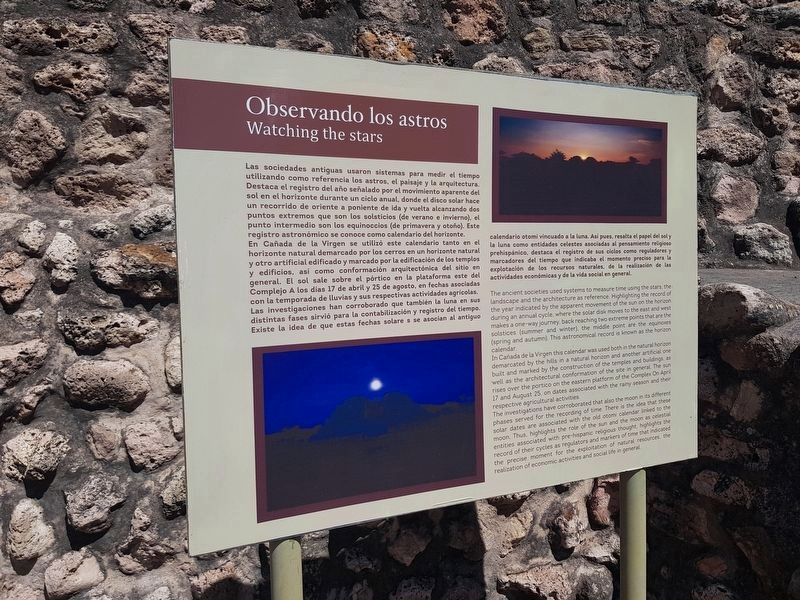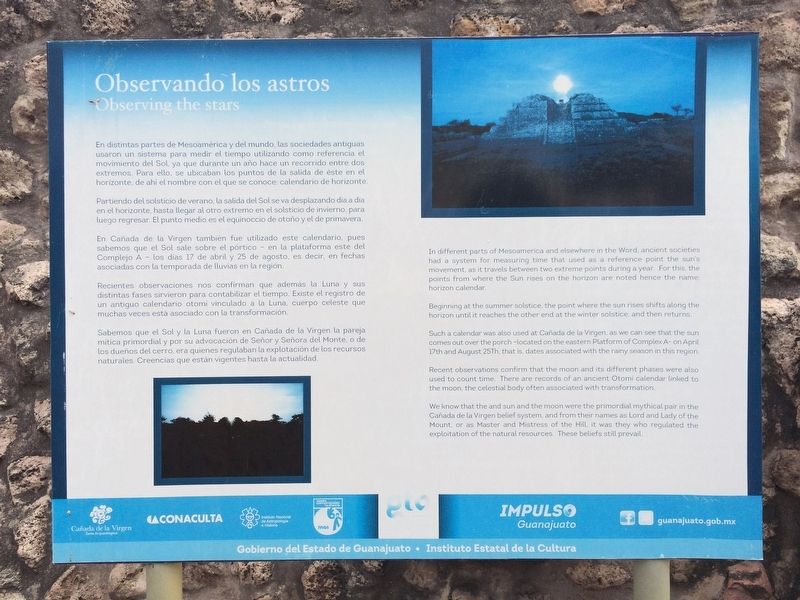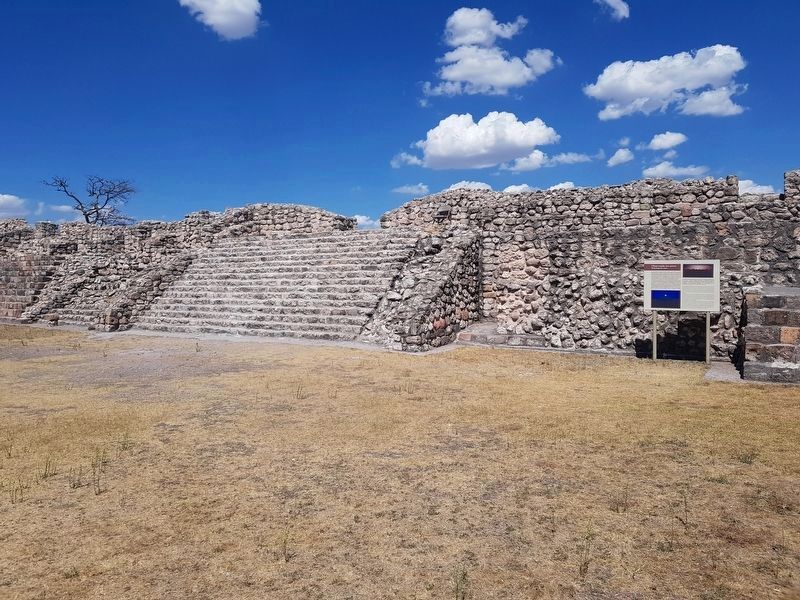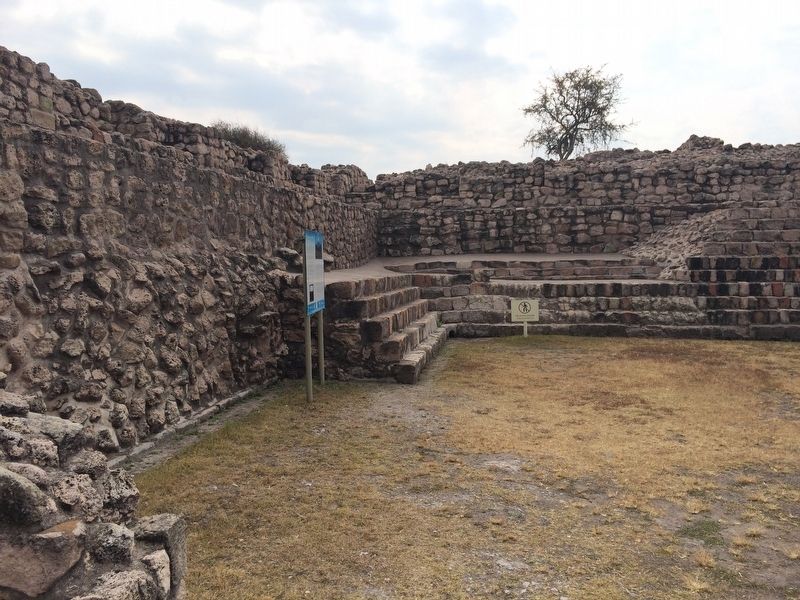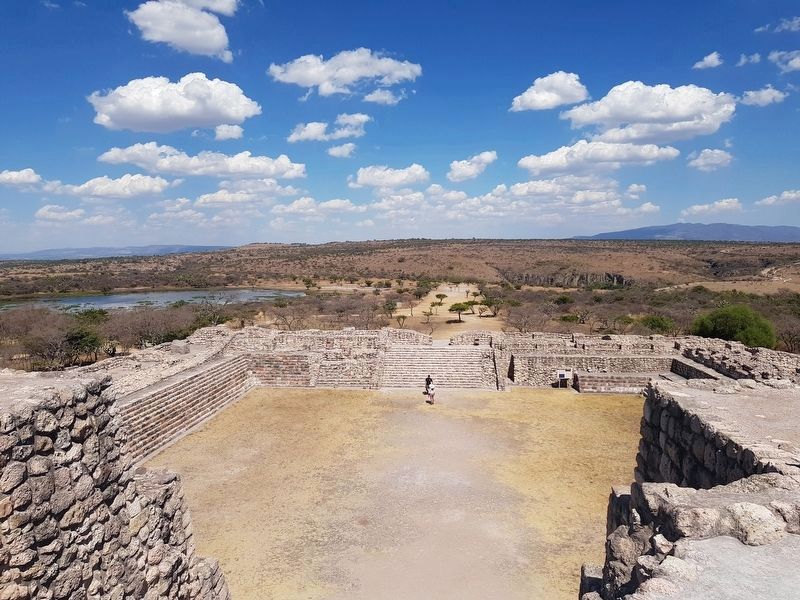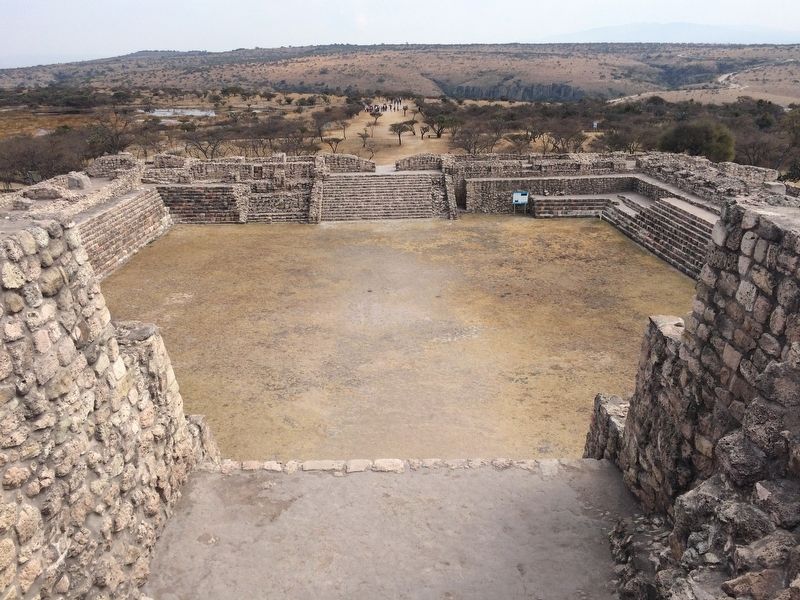San Miguel de Allende, Guanajuato, Mexico — The Central Highlands (North America)
Observing the Stars
Inscription.
Las sociedades antiguas usaron sistemas para medir el tiempo utilizando como referencia los astros, el paisaje y la arquitectura. Destaca el registro del año señalado por el movimiento aparente del sol en el horizonte durante un ciclo anual, donde el disco solar hace un recorrido de oriente a poniente de ida y vuelta alcanzando dos puntos extremos que son los solsticios (de verano e invierno), el punto intermedio son los equinoccios (de primavera y otoño). Este registro astronómico se conoce como calendario del horizonte. En Cañada de la Virgen se utilizó este calendario tanto en el horizonte natural demarcado por los cerros en un horizonte natural y otro artificial edificado y marcado por la edificación de los templos y edificios, así como conformación arquitectónica del sitio en general. El sol sale sobre el pórtico en la plataforma este del Complejo A los días 17 de abril y 25 de agosto, en fechas asociadas con la temporada de lluvias y sus respectivas actividades agrícolas. Las investigaciones han corroborado que también la luna en sus distintas fases sirvió para la contabilización y registro del tiempo. Existe la idea de que estas fechas solare s se asocian al antiguo calendario otomí vincuado a la luna. Así pues, resalta el papel del sol y la luna como entidades celestes asociadas al pensamiento religioso prehispánico, destaca el registro de sus ciclos como reguladores y marcadores del tiempo que indicaba el momento preciso para la explotación de los recursos naturales, de la realización de las actividades económicas y de la vida social en general.
Watching the stars
The ancient societies used systems to measure time using the stars, the landscape and the architecture as reference. Highlighting the record of the year indicated by the apparent movement of the sun on the horizon during an annual cycle, where the solar disk moves to the east and west makes a one-way journey, back reaching two extreme points that are the solstices (summer and winter), the middle point are the equinoxes (spring and autumn). This astronomical record is known as the horizon calendar.
In Cañada de la Virgen this calendar was used both in the natural horizon demarcated by the hills in a natural horizon and another artificial one built and marked by the construction of the temples and buildings, as well as the architectural conformation of the site in general. The sun rises over the portico on the eastern platform of the Complex On April 17 and August 25, on dates associated with the rainy season and their respective agricultural activities.
The investigations have corroborated that also the moon in its different phases served for the recording of time. There is the idea that these solar dates are associated with the old otomí calendar linked to the moon. Thus, highlights the role of the sun and the moon as celestial entities associated with pre-hispanic religious thought, highlights the record of their cycles as regulators and markers of time that indicated the precise, moment for the exploitation of natural resources, the realization of economic activities and social life in general.
Erected by Consejo Nacional para la Cultura y las Artes de México (CONACULTA)-INAH.
Topics. This historical marker is listed in these topic lists: Anthropology & Archaeology • Architecture • Man-Made Features • Native Americans. A significant day of the year for for this entry is April 17.
Location. 20° 51.496′ N, 100° 55.684′ W. Marker is in San Miguel de Allende, Guanajuato. Marker can be reached from Route 67. The marker is in a plaza to the east of the main pyramid at the archaeological site of Cañada de la Virgen. The site is to the left when traveling north on State Road 67, some 30 km west of San Miguel de Allende.
Touch for map. Marker is in this post office area: San Miguel de Allende GTO 37701, Mexico. Touch for directions.
Other nearby markers. At least 8 other markers are within walking distance of this marker. Complex A The House of the Thirteen Heavens (within shouting distance of this marker); Burial 13 The hierarch and ancestral veneration (within shouting distance of this marker); Cañada de la Virgen: A Ceremonial Civic Center in the Laja River Basin Marker (about 90 meters away, measured in a direct line); Complex B: The House of the Longest Night (about 90 meters away); Layout and Architecture (about 120 meters away); Ceremonial Road (about 120 meters away); Burial 18 The Decapitated Man (about 120 meters away); Complex D. The wind house. (The house of the wind) (about 120 meters away). Touch for a list and map of all markers in San Miguel de Allende.
Regarding Observing the Stars. The previous marker had the following text:
Observando los astros
En distintas partes de Mesoamérica y del mundo, las sociedades antiguas usaron un sistema para medir el tiempo utilizando como referencia el movimiento del Sol, ya que durante un año hace un recorrido entre dos extremos. Para ello, se ubicaban los puntos de la salida de éste en el horizonte, de ahí el nombre con el que se conoce: calendario de horizonte.
Partiendo del solsticio de verano, la salida del Sol se va desplazando día a día en el horizonte, hasta llegar al otro extremo en el solsticio de invierno, para luego regresar. El punto medio es el equinoccio de otoño y el de primavera.
En Cañada de la Virgen también fue utilizado este calendario, pues sabemos que el Sol sale sobre el pórtico - en la plataforma este del Complejo A - los días 17 de abril y 25 de agosto, es decir, en fechas asociadas con la temporada de lluvias en la región.
Recientes observaciones nos confirman que además la Luna y sus distintas fases sirvieron para contabilizar el tiempo. Existe el registro de un antiguo calendario otomí vinculado a la Luna, cuerpo celeste que muchas veces está asociado con la transformación.
Sabemos que el Sol y la Luna fueron en Cañada de la Virgen la pareja mítica primordial y por su advocación de Señor y Señora del Monte, o de los dueños del cerro, era quienes regulaban la explotación de los recursos naturales, Creencias que están vigentes hasta la actualidad.
English:
Observing the stars
In different parts of Mesoamerica and elsewhere in the World, ancient societies had a system for measuring time that used as a reference point the sun’s movement, as it travels between two extreme points during a year. For this, the points from where the Sun rises on the horizon are noted hence the name:
horizon calendar.
Beginning at the summer solstice, the point where the sun rises shifts along the horizon until it reaches the other end at the winter solstice, and then returns.
Such a calendar was also used at Cañada de la Virgen, as we can see that the sun comes out over the porch - located on the eastern Platform of Complex A – on April 17th and August 25Th, that is, dates associated with the rainy season in this region.
Recent observations confirm that the moon and its different phases were also used to count time. There are records of an ancient Otomí calendar linked to the moon, the celestial body often associated with transformation.
We know that the and sun and the moon were the primordial mythical pair in the Cañada de la Virgen belief system, and from their names as Lord and Lady of the Mount, or as Master and Mistress of the Hill, it was they who regulated the exploitation of the natural resources. These beliefs still prevail.
Credits. This page was last revised on September 1, 2020. It was originally submitted on June 7, 2017, by J. Makali Bruton of Accra, Ghana. This page has been viewed 128 times since then and 6 times this year. Photos: 1. submitted on November 24, 2019, by J. Makali Bruton of Accra, Ghana. 2. submitted on June 7, 2017, by J. Makali Bruton of Accra, Ghana. 3. submitted on November 24, 2019, by J. Makali Bruton of Accra, Ghana. 4. submitted on June 7, 2017, by J. Makali Bruton of Accra, Ghana. 5. submitted on November 24, 2019, by J. Makali Bruton of Accra, Ghana. 6. submitted on June 7, 2017, by J. Makali Bruton of Accra, Ghana.
